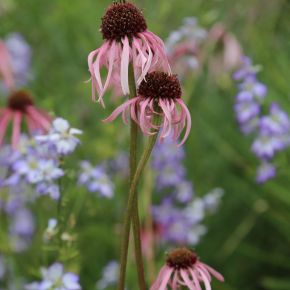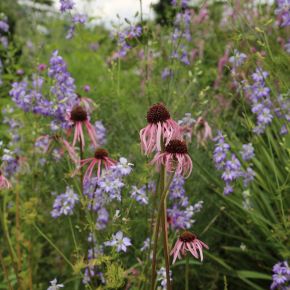Echinacea angustifolia
(Narrow-leaved Coneflower)
Family - Asteraceae
Category - Perennial
Origin - Central North America
Year of Introduction - 1861
Season of Interest - Summer, Autumn
Hardiness - H5
Height - up to 120cm
Width - 50cm
Location - The Cool Garden
Description: A herbaceous Perennial with a clump-forming, upright habit. Bristly, dark green leaves are lanceolate in shape. Daisy-like flowers have a ring of reflexed, rosy-pink petals that surround a large, reddish-brown central cone. The flowers are held singly atop upright stems and are produced from midsummer into early autumn, and the central cone remains attractive after the petals have dropped. Attractive to pollinating insects.
Echinacea angustifolia is prized for its medicinal value and is traditionally used as an anti-viral and a painkiller. Many other uses are reported and this plant is often the subject of pharmaceutical research.
'Echinos' is the Greek word for hedgehog, a reference to the prickly centre of the flower.
Flower:
Daisy-like flowerheads are composed of narrow, reflexed, rosy-pink ray florets (petals) surrounding a large, reddish-brown central cone of disc florets and stiff, pointed bracts. The flowers are held atop upright stems and produced from late June into September.
Flower colour: Pink
Flower shape: Daisy-like flowers, disc and ray florets, held singly
Flowering time: June, July, August, September
Foliage:
Bristly dark green leaves are lanceolate in shape. The leaves are mostly held at the base of the plant with fewer leaves Alternately arranged on the flowering stems.
Foliage Senescence: Deciduous
Foliage Shape: Lanceolate
Pest and Diseases:
Protect the emerging leaves from slugs in spring.
Propagation:
Seed, division.
Cultivation:
Best in full sun in rich, moisture-retentive soil that is well-drained.

